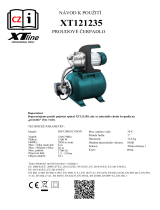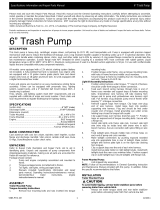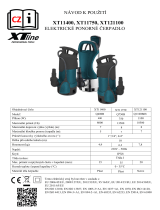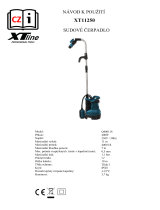
INSTRUCTION MANUAL
OF
SUCTION AND PUMPING
DEVICE 230V, 400V 0.37 kW and
1.5kW
Przedsiębiorstwo Pszczelarskie/Apiarian Enterprise
Thomas Łysoń
Limited liability company, limited partnership
Racławicka Str. No. 162, PL-34125 Sułkowice, Poland
www.lyson.com.pl, email; [email protected]
phone: +48 33/875-99-40, 33/870-64-02
Company's registered office - Klecza Dolna 148, PL-34124 Klecza Górna

Instruction manual involves devices about codes:
suction and pumping devices, power supply 400 V
w2021GN, w20210GN
Suction and pumping devices, power supply 230 V
w2021GNF, W20210GNF
1. General safety rules of utilisation of device
1.1. Electrical safety
1.2. Operational safety
2. The use of suction and pumping devices
3. Work commencement with suction and
pumping device
3.1. Preparation of the device to operation
4. Characterization of suction and pumping
devices
4.1. Suction and pumping devices with the power
supply for 400V
4.2. Suction and pumping devices with the power
supply for 230V
5. Technical parameters of devices
6. Error codes
7. Maintenance of suction and pumping devices
8. Storage
9. Disposal
10. Warranty

INSTRUCTION MANUAL
Suction and pumping device
for creaming and pumping honey
(PUMPS FOR HONEY)
400V, 230V
The device is intended to pumping operation of honey.
IMPORTANT!
Before using the device, be sure to read the instructions for use
and follow the instructions contained therein. The manufacturer
is not liable for damages caused by the use of the device
contrary to its intended purpose or inappropriate handling.
1. General safety rules of utilisation of device
1.1. Electrical safety
1. Before you switch on the appliance to the mains, one
should make sure that the control is off. The ”0/1” switch
should be in the ”0” position and knob in the "min" position
(model with an inverter 230V). ”Right”; ”Left” switch
should be in a ”0” position!
2. Make sure that nominal voltage of the device and the
power supply source are compatible.
3. The device must be connected to the socket with earthing
with the voltage specified on the nameplate of the
product.
4. Electrical Installation powering the device must be
equipped with RCD (residual current device) with a rated
tripping current In no higher than 30mA.
5. Check the function of the RCBO (residual current
operated circuit-breaker with integral overcurrent
protection) periodically.
6. Periodically check the status of the power cord. If the
power cord without the possibility of disconnection is
damaged and you need to replace it, then this operation
should be carried out as guarantor or by a specialised
repair facility or a qualified person in order to avoid the
risk. Not use the device when the power cord is damaged.
7. During connecting to the mains, one should be careful.
8. It is forbidden to pull the power cord.
9. The power cord must be kept away from heat sources,
sharp edges and take care of its satisfactory condition.
10. Protect the device against moisture;( also during storage)
1.2. Operational safety
1. This equipment is not intended for use by persons (including
children) with reduced physical, sensory or mental
capabilities , or lack of experience and knowledge concerning
the equipment unless this is done under the supervision or in
accordance with the instructions for use of the equipment,
handed over by persons responsible for their safety.
2. You should pay attention to the children, to ensure they do
not play with the pump.
3. In the case of pump failure, in order to avoid a hazard, the
repair can only perform specialised repair facility or a qualified
person.
4. Do not use the device in the vicinity of flammable materials.
5. Do not carry out any maintenance work when the device is
operating.
6. All guards when the appliance is operating must be
permanently attached to the device.
7. In the event of any hazard, you should immediately stop the
pump operation.
8. Restarting the pump may occur after the elimination of the
hazard.
9. The device should only be started inside the premises.
Ban on removing guards when operating the device.
Ban on repairing the device which is in motion.
2. The use of suction and pumping devices
Due to the low speed, pumps are perfectly suited for the
pumping (forcing through) of sensitive liquids – do not cause
their effervescence or carbonation.
Not be used for pumping flammable substances!
3. Work commencement with suction and
pumping device
1. Depending on the type of pump, before the work
commencement, the switch must be set in ”0” position and
knob in ”min” position.
2. Place of work should be illuminated and kept as clean as
possible.
3. Before using, one should exactly clean the pump.
4. When washing pump, one should take special care, in
order to prevent to the moistness/dampness of the engine
and pump control.
5. Then, we connect hoses of suitable diameter from both
sides of the rotor with the help of hose connectors
(equipped with pump).
6. Before starting, one should pour over the rotor with honey.
7. Switch on the pump to the supply network and check the
direction of pumping starting/actuating the pump.
8. If the direction is different from the desired, we stop the
pump and we switch the direction on the controller.
9. After completed pumping, wash and dry the device.
3.1. Preparation of the device to operation

ATTENTION!
BEFORE WORK COMMENCEMENT WITH PUMP,
ONE SHOULD POUR OVER ROTOR WITH HOT WATER
(APPROXIMATELY 60 DEGREES)
Directions (for user):
1. On both outlets of the rotor, we connect conduits, put
the hose.
Correct fastening the hose:
We unbuckle the tip/end for the hose
We slide the end/tip into the hose and firmly
clamp band clip
We prepare the hose,tip/end and band clip
We place the seal
We put to the hose
We connect the hose to the rotor with the help
of the quick release coupling

2. We pour down honey in an amount of about 1kg (ie.
0.95 kg jar).
3. Hold the conduit up as long as the honey flows down
into the rotor.
4. When honey reaches to the rotor, one should place the
hose in the tank/container with honey and turn on the
pump, remembering to under the second conduit put
honey container.
5. When pump will suck in and will pump a little honey, we
stop the functioning of the pump and we proceed to
work.
6. Before pumping, honey should be heated to a
temperature of 30°C.
The pump cable isn't included in a device.
4. Characterization of suction and pumping
devices
4.1. Suction and pumping devices with the power
supply for 400V
Pumps with power supply for the 400V have the
controller with a knob for ”P”(right), ”L” (left) and ”0” (stop)
position.
Applied engine for 400V with gear-motor, without
the inverter, is powered at 400V voltage.
Depending on the electrical installation, the engine will spin
to the left or right.
The switch to the right –”P”, or to the left - „L”, is used to
select the direction of pumping.
We stop the pump by turning the switch to the stop position,
that is ”0”.
Before pumping, one should check the direction of
pumping.
Photo 1. Suction and pumping device 0.37 kW, 1.5 kW, 400 V
Code of the
pump
Suction and pumping device for creaming and
pumping honey
W2021GN
0.37 kW, 400V - 0 -360 rpm
W20210GN
1.5 kW, 400V - 0-560 rpm
4.2. Suction and pumping devices with the power
supply for 230V
Pumps with inverter 230V are equipped with control,
which gives the ability to increasing or decreasing the speed
of the honey pumping with the help of a knob (of the
potentiometer). The controller has two buttons - arrow ”Right
(CW)” and arrow ”Left (CCW)”, which are used to actuate the
pump.
The direction of the pumping, we select with the help of
buttons - arrow ”Right (CW)” and arrow ”Left (CCW)”, and we
stop the pump with the help of red ”STOP” button.
Engine 400V with gear-motor and the frequency inverter
applied (inverter) enables the smooth adjustment of the
rotational speed and the power supply for the 230V.
Rotor speed, we set with the potentiometer.
The direction of speed, we change by pressing the left
arrow or the right arrow.
Photo 2. Suction and pumping device 0.37 kW, 230 V
Correct fastening of the hose to the rotor

Photo 3. Suction and pumping device 1.5 kW, 230 V
Slow-speed pumps:
Code of the
pump
Suction and pumping device for creaming and
pumping of honey
W2021GNF
0.37 kW, 230V - range from 0 to 360 rpm
(speed adjustment with the help of knob)
W20210GNF
1.5 kW, 230V - ranges from 0 to 560 rpm
(speed adjustment with the help of a knob)
Suction and pumping devices - for forcing through, pumping
honey. Rotor housing made of stainless steel with elastomer
rotor.
5. Technical parameters of devices:
Suction and pumping pumps to honey are divided into two
types:
Suction and pumping devices 0.37kW:
- power 0.37 kW
-optimum performance 900l/h, at a temperature of 30° C for
honey
- power supply 400V
-gear-motor
- after applying the inverter, power supply for 230V with
smooth adjustment.
Suction and pumping devices 1.5kW:
- power 1.5 kW
-optimum performance 1500 l/h, at a temperature of 30° C
for honey
- power supply 400V
-gear-motor
- after applying the inverter, power supply for 230V with
smooth adjustment.
Both types of suction and pumping devices are equipped
with road wheels and a handle for easy changing the
position of suction and pumping device.
6. Error codes
STOP
2 Hz
E-000
INTERNAL DEFECT OF THE MICROPROCESSOR
CONTROLLER
STOP
2 Hz
E-001
PRESSED / LOCKED THE START BUTTON
DIRECTION - LEFT
STOP
2 Hz
E-002
PRESSED / LOCKED THE STOP BUTTON
STOP
2 Hz
E-003
PRESSED / LOCKED THE START BUTTON
DIRECTION - RIGHT
STOP
2 Hz
E-004
ERROR OF THE ALARM LOOP - EMERGENCY BUTTON
PRESSED

6. Maintenance of suction and pumping
devices
IMPORTANT!
Suction and pumping device after the finished work, one
should carefully wash in order to remove residual honey,
bearing in mind the protection of electrical components.
Directly after work with the device, we put suction conduit
into a container with hot water and we are pumping 40l of
heated water, to rinse the module of suction and pumping
device.
We pump and we pour out water, this operation can be
repeated several times. To cleaning/washing of suction and
pumping device, one should prepare approximately 40 l of
water heated to a temperature from 50°C to 60°C. This
process is necessary and protects the device from damage,
which can cause crystallised honey (ie. disruption/tearing of
the seal and leakage of honey). In the case of improper
maintenance, will occur disruption/tearing of sealant on the
shaft of the pumping module. Damage resulting from
improper cleaning module is not covered by warranty.
8. Storage
After the completion of the work, the pump must be thoroughly
cleaned and dried.
Before each new season, one should make an additional
technical review, and in the event of fault detection, please
contact the service centre.
The device should not be enabled, if the ambient
temperature is lower than 5º C. Before starting the device,
in the case when it has been moved from the room with the
lower temperature to spaces of higher temperature, you
should wait until it reaches the ambient temperature.
9. Disposal
The worn out product shall be subject to disposal as waste
only in the selective collection of waste organised by Network
of Municipal Collection points for Waste Electrical and
Electronic Equipment. The consumer shall have the right to
return used equipment in the electrical equipment distributor
network, at least, free of charge and directly if a device that
is returned is the proper kind and provides the same
functionality as the newly purchased equipment.
10. Warranty
Products purchased in the ”Łysoń” company are covered by
manufacturer's warranty.
The warranty period is 24 months.
On purchased products shall be issued a receipt or VAT
invoice.
Warranty details are available on the website -
www.lyson.com.pl
-
 1
1
-
 2
2
-
 3
3
-
 4
4
-
 5
5
-
 6
6
-
 7
7
Lyson W20210GNF Instrukcja obsługi
- Typ
- Instrukcja obsługi
w innych językach
- English: Lyson W20210GNF Owner's manual
Powiązane artykuły
Inne dokumenty
-
 Avent SCF300/12 Instrukcja obsługi
Avent SCF300/12 Instrukcja obsługi
-
 Avent SCF302/01 Instrukcja obsługi
Avent SCF302/01 Instrukcja obsługi
-
Avent SCD236/00 Instrukcja obsługi
-
 XTline XT121235 Instrukcja obsługi
XTline XT121235 Instrukcja obsługi
-
 IPT Pumps 5581--96 Instrukcja obsługi
IPT Pumps 5581--96 Instrukcja obsługi
-
ULTIMATE SPEED UOP 12 A1 Operating Instructions Manual
-
 XTline XT11400 Instrukcja obsługi
XTline XT11400 Instrukcja obsługi
-
 XTline XT11250 Instrukcja obsługi
XTline XT11250 Instrukcja obsługi
-
Varian TPS-compac 969-8229 Instrukcja obsługi
-
Ardo 9904.425 Instrukcja obsługi




















